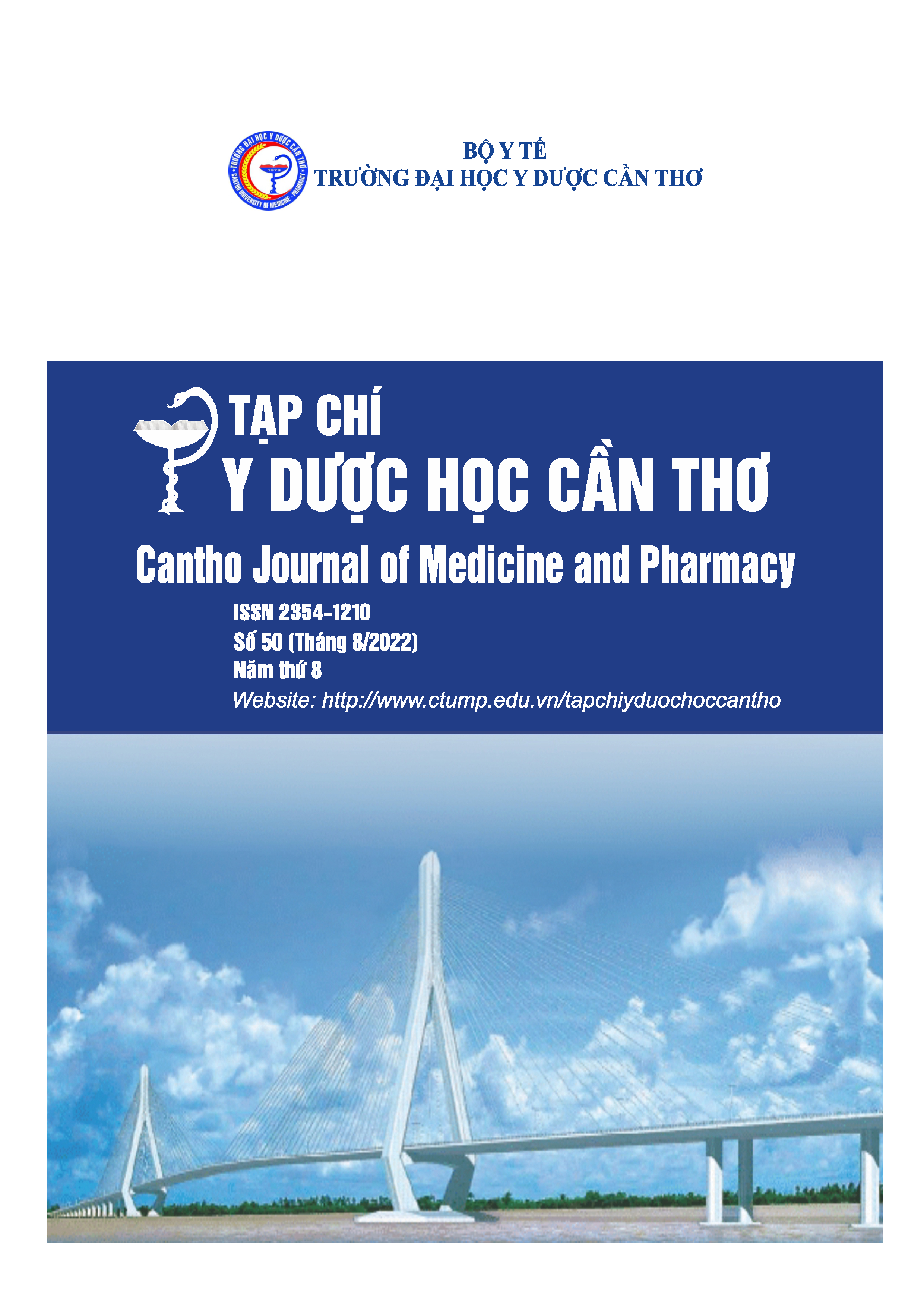THE RESULTS OF ANTERIOR CERVICAL DISCECTOMY AND FUSION FOR TREATMENT OF THE CERVICAL DISC HERNIATION AT CAN THO CENTRAL GENERAL HOSPITAL
Main Article Content
Abstract
Background: Cervical disc herniation is a disease caused by degenerative cervical disc herniation, causing compression of the cervical spinal cord or nerve roots. Previous papers demonstrated that anterior surgical treatment of intervertebral disc fusion using autologous bone from the iliac crest is a gold standard in the treatment of disc herniation. Objective: To describe clinical and paraclinical characteristics and evaluate the results of treatment of cervical disc herniation by anterior cervical discectomy and fusion at Can Tho Central General Hospital from 2021-2022. Materials and methods: A cross-sectional descriptive study on 36 patients with cervical disc herniation operated by anterior cervical discectomy and fusion at Can Tho Central General Hospital from February 2021 to November 2021. Results: Myelopathy was most seen in 77.8% of the patients, myeloradiculopathy and radiculopathy were respectively seen in 16.6% and 5.6%.Location of hernia: C4-C5 level most (44.4%), C5-C6 level (36.1%). 80.1% of patients had their cervical lordosis restored. The recovery ratio of JOA showed good and excellent results accounting for 88.24%, while acceptable results accounted for 11.76%. Conclusion: Disc herniation in the cervical spine was surgically removed by anterior discectomy and fusion to relieve spinal cord and nerve root compression, with a very high rate of anatomical and functional recovery that demonstrated good outcomes with excellent anatomical and functional recovery.
Article Details
Keywords
Anterior cervical discectomy and fusion, autograft bone, cervical spondylosis, disc hernia
References
2. Hoàng Văn Chiến (2016), “Đánh giá kết quả điều trị thoát vị đĩa đệm cột sống cổ bằng phẫu thuật thay đĩa đệm nhân tạo có khớp”, Luận văn Tiến sỹ Y học, Học Viện Quân Y.
3. Hồ Hữu Lương (2019), Thoái hóa cột sống cổ và thoát vị đĩa đệm, Nhà xuất bản Y học, Hà Nội.
4. Bùi Tiến Nguyện (2021), “Kết quả điều trị thoát vị đĩa đệm cột sống cổ bằng kĩ thuật ACDF tại Bệnh viện Đại học Y Hà Nội”, Luận văn Thạc sĩ, Đại học Y Hà Nội.
5. Lê Trọng Sanh (2010), “Nghiên cứu chẩn đoán và kết quả điều trị phẫu thuật thoát vị đĩa đệm cột sống cổ bằng đường mổ cổ trước bên tại Bệnh viện Việt Đức”, Luận án Tiến sĩ Y học, Đại học Y Hà Nội.
6. Nguyễn Mạnh Tuyên (2016), “Kết quả điều trị thoát vị đĩa đệm cột sống cổ bằng phương pháp lấy đĩa đệm, hàn xương liên thân đốt và nẹp vít cột sống cổ lối trước”, Luận văn Thạc sĩ Y học, Đại học Y Hà Nội.
7. Gaetani P. et al. (1995), “Anterior cervical discectomy: an analysis on clinical long-term results in 153 cases”, J Neurosurg Sci, 39(4), pp.211-218.
8. Japanese Clinical Orthopaedic Association (1994), “Japanese Orthopaedic Association Scoring system for cervical myelopathy”, The Journal of the Japanese Clinical Orthopaedic Association, 68(1994), pp.490-503.
9. Lundine K. M., Rogers M. et al. (2014), “Prevalence of adjacent segment disc degeneration in patients undergoing anterior cervical discectomy and fusion based onpre-operative MRI findings”, Journal of Clinical Neuroscience, 21(1), pp. 82-85.
10. Radhakrishnan K. et al. (1994), “Epidemiology of cervical radiculopathy. A population-based study from Rochester, Minnesota, 1976 through 1990”, Brain, 117(1), pp.325-335.
11. Tanaka Y., Kokubun S., Sato T. (1998), “Cervical radiculopathy and its unsolved problems”, Current Orthopaedics, 12(1), pp.1-6.
12. Wei L., Cao P., Xu C. et al. (2018), “Clinical and Radiologic Results of Anterior Cervical Discectomy and Fusion for Cervical Spondylotic Myelopathy in Elderly Patients with T2-Weighted Increased Signal Intensity”, World Neurosurg, 112(7), pp.520-526.
13. Yson S. C. et al. (2017), “Comparison of allograft and polyetheretherketone (PEEK) cage subsidence rates in anterior cervical discectomy and fusion (ACDF)”, Journal of Clinical Neuroscience, 37(2017), pp.118-121.


